Various - Birds, Illustrated by Color Photography, Vol. 1, No. 6
Здесь есть возможность читать онлайн «Various - Birds, Illustrated by Color Photography, Vol. 1, No. 6» — ознакомительный отрывок электронной книги совершенно бесплатно, а после прочтения отрывка купить полную версию. В некоторых случаях можно слушать аудио, скачать через торрент в формате fb2 и присутствует краткое содержание. Жанр: periodic, Биология, Природа и животные, foreign_edu, на английском языке. Описание произведения, (предисловие) а так же отзывы посетителей доступны на портале библиотеки ЛибКат.
- Название:Birds, Illustrated by Color Photography, Vol. 1, No. 6
- Автор:
- Жанр:
- Год:неизвестен
- ISBN:нет данных
- Рейтинг книги:4 / 5. Голосов: 1
-
Избранное:Добавить в избранное
- Отзывы:
-
Ваша оценка:
- 80
- 1
- 2
- 3
- 4
- 5
Birds, Illustrated by Color Photography, Vol. 1, No. 6: краткое содержание, описание и аннотация
Предлагаем к чтению аннотацию, описание, краткое содержание или предисловие (зависит от того, что написал сам автор книги «Birds, Illustrated by Color Photography, Vol. 1, No. 6»). Если вы не нашли необходимую информацию о книге — напишите в комментариях, мы постараемся отыскать её.
Birds, Illustrated by Color Photography, Vol. 1, No. 6 — читать онлайн ознакомительный отрывок
Ниже представлен текст книги, разбитый по страницам. Система сохранения места последней прочитанной страницы, позволяет с удобством читать онлайн бесплатно книгу «Birds, Illustrated by Color Photography, Vol. 1, No. 6», без необходимости каждый раз заново искать на чём Вы остановились. Поставьте закладку, и сможете в любой момент перейти на страницу, на которой закончили чтение.
Интервал:
Закладка:
Various
Birds, Illustrated by Color Photography, Vol. 1, No. 6 / June, 1897
KNOWLEDGE OF BIRD-LIFE
“With cheerful hop from perch to spray,
They sport along the meads;
In social bliss together stray,
Where love or fancy leads.
Through spring’s gay scenes each happy pair
Their fluttering joys pursue;
Its various charms and produce share,
Forever kind and true.”
PREFACE
IT has become a universal custom to obtain and preserve the likenesses of one’s friends. Photographs are the most popular form of these likenesses, as they give the true exterior outlines and appearance, (except coloring) of the subjects. But how much more popular and useful does photography become, when it can be used as a means of securing plates from which to print photographs in a regular printing press, and, what is more astonishing and delightful, to produce the real colors of nature as shown in the subject, no matter how brilliant or varied.
We quote from the December number of the Ladies’ Home Journal:
“ An excellent suggestion was recently made by the Department of Agriculture at Washington that the public schools of the country shall have a new holiday, to be known as Bird Day. Three cities have already adopted the suggestion, and it is likely that others will quickly follow. Of course, Bird Day will differ from its successful predecessor, Arbor Day. We can plant trees but not birds. It is suggested that Bird Day take the form of bird exhibitions, of bird exercises, of bird studies – any form of entertainment, in fact, which will bring children closer to their little brethren of the air, and in more intelligent sympathy with their life and ways. There is a wonderful story in bird life, and but few of our children know it. Few of our elders do, for that matter. A whole day of a year can well and profitably be given over to the birds. Than such study, nothing can be more interesting. The cultivation of an intimate acquaintanceship with our feathered friends is a source of genuine pleasure. We are under greater obligations to the birds than we dream of. Without them the world would be more barren than we imagine. Consequently, we have some duties which we owe them. What these duties are only a few of us know or have ever taken the trouble to find out. Our children should not be allowed to grow to maturity without this knowledge. The more they know of the birds the better men and women they will be. We can hardly encourage such studies too much.”
Of all animated nature, birds are the most beautiful in coloring, most graceful in form and action, swiftest in motion and most perfect emblems of freedom.
They are withal, very intelligent and have many remarkable traits, so that their habits and characteristics make a delightful study for all lovers of nature. In view of the facts, we feel that we are doing a useful work for the young, and one that will be appreciated by progressive parents, in placing within the easy possession of children in the homes these beautiful photographs of birds.
The text is prepared with the view of giving the children as clear an idea as possible, of haunts, habits, characteristics and such other information as will lead them to love the birds and delight in their study and acquaintance.
NATURE STUDY PUBLISHINGBIRD SONG
“I cannot love the man who doth not love,
As men love light, the song of happy birds.”
IT is indeed fitting that the great poets have ever been the best interpreters of the songs of birds. In many of the plays of Shakespeare, especially where the scene is laid in the primeval forest, his most delicious bits of fancy are inspired by the flitting throng. Wordsworth and Tennyson, and many of the minor English poets, are pervaded with bird notes, and Shelley’s masterpiece, The Skylark, will long survive his greater and more ambitious poems. Our own poet, Cranch, has left one immortal stanza, and Bryant, and Longfellow, and Lowell, and Whittier, and Emerson have written enough of poetic melody, the direct inspiration of the feathered inhabitants of the woods, to fill a good-sized volume. In prose, no one has said finer things than Thoreau, who probed nature with a deeper ken than any of his contemporaries. He is to be read, and read, and read.
But just what meaning should be attached to a bird’s notes – some of which are “the least disagreeable of noises” – will probably never be discovered. They do seem to express almost every feeling of which the human heart is capable. We wonder if the Mocking Bird understands what all these notes mean. He is so fine an imitator that it is hard to believe he is not doing more than mimicking the notes of other birds, but rather that he really does mock them with a sort of defiant sarcasm. He banters them less, perhaps, than the Cat Bird, but one would naturally expect all other birds to fly at him with vengeful purpose. But perhaps the birds are not so sensitive as their human brothers, who do not always look upon imitation as the highest flattery.
A gentleman who kept a note-book, describes one of the matinee performances of the Mocker, which he attended by creeping under a tent curtain. He sat at the foot of a tree on the top of which the bird was perched unconscious of his presence. The Mocker gave one of the notes of the Guinea-hen, a fine imitation of the Cardinal, or Red Bird, an exact reproduction of the note of the Phoebe, and some of the difficult notes of the Yellow-breasted Chat. “Now I hear a young chicken peeping. Now the Carolina Wren sings, ‘ cheerily, cheerily, cheerily .’ Now a small bird is shrilling with a fine insect tone. A Flicker, a Wood-pewee, and a Phoebe follow in quick succession. Then a Tufted Titmouse squeals. To display his versatility, he gives a dull performance which couples the ‘ go-back ’ of the Guinea fowl with the plaint of the Wood-pewee, two widely diverse vocal sounds. With all the performance there is such perfect self-reliance and consciousness of superior ability that one feels that the singer has but to choose what bird he will imitate next.”
Nor does the plaintive, melancholy note of the Robin, that “pious” bird, altogether express his character. He has so many lovely traits, according to his biographers, that we accept him unhesitatingly as a truly good bird. Didn’t he once upon a time tenderly cover with leaves certain poor little wanderers? Isn’t he called “The Bird of the Morning?” And evening as well, for you can hear his sad voice long after the sun has himself retired.
The poet Coleridge claims the credit of first using the Owl’s cry in poetry, and his musical note Tu-whit, tu-who! has made him a favorite with the poets. Tennyson has fancifully played upon it in his little “Songs to the Owl,” the last stanza of which runs:
“I would mock thy chant anew;
But I cannot mimic it,
Not a whit of thy tuhoo,
Thee to woo to thy tuwhit,
Thee to woo to thy tuwhit.
With a lengthen’d loud halloo,
Tuwhoo, tuwhit, tuwhit, tuhoo-o-o.”
But Coleridge was not correct in his claim to precedence in the use of the Owl’s cry, for Shakespeare preceded him, and Tennyson’s “First Song to the Owl” is modeled after that at the end of “Love’s Labor Lost:”
“When roasted crabs hiss in the bowl,
Then nightly sings the staring Owl,
Tu-who;
Tu-whit, tu-who, a merry note.”
In references to birds, Tennyson is the most felicitous of all poets and the exquisite swallow-song in “The Princess” is especially recommended to the reader’s perusal.
Birds undoubtedly sing for the same reasons that inspire to utterance all the animated creatures in the universe. Insects sing and bees, crickets, locusts, and mosquitos. Frogs sing, and mice, monkeys, and woodchucks. We have recently heard even an English Sparrow do something better than chipper; some very pretty notes escaped him, perchance, because his heart was overflowing with love-thoughts, and he was very merry, knowing that his affection was reciprocated. The elevated railway stations, about whose eaves the ugly, hastily built nests protrude everywhere, furnish ample explanation of his reasons for singing.
Читать дальшеИнтервал:
Закладка:
Похожие книги на «Birds, Illustrated by Color Photography, Vol. 1, No. 6»
Представляем Вашему вниманию похожие книги на «Birds, Illustrated by Color Photography, Vol. 1, No. 6» списком для выбора. Мы отобрали схожую по названию и смыслу литературу в надежде предоставить читателям больше вариантов отыскать новые, интересные, ещё непрочитанные произведения.
Обсуждение, отзывы о книге «Birds, Illustrated by Color Photography, Vol. 1, No. 6» и просто собственные мнения читателей. Оставьте ваши комментарии, напишите, что Вы думаете о произведении, его смысле или главных героях. Укажите что конкретно понравилось, а что нет, и почему Вы так считаете.
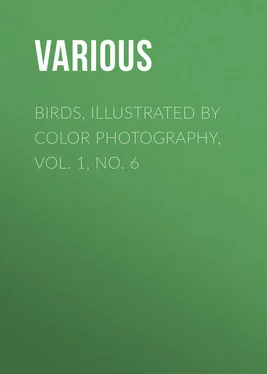



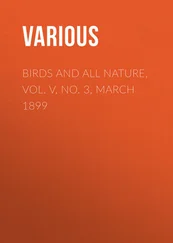
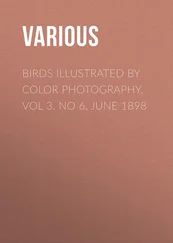
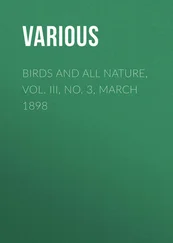
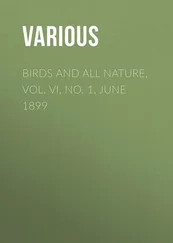
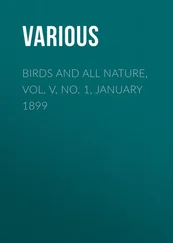

![Various - Birds Illustrated by Color Photography [January, 1898]](/books/746296/various-birds-illustrated-by-color-photography-ja-thumb.webp)

![Various - Birds Illustrated by Color Photography [February, 1898]](/books/746443/various-birds-illustrated-by-color-photography-fe-thumb.webp)